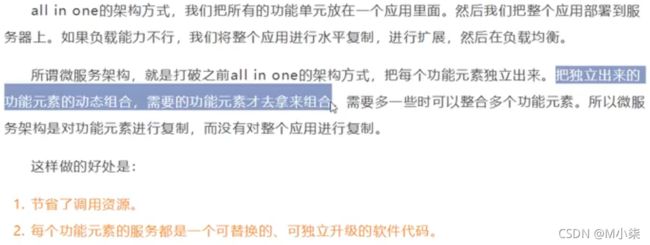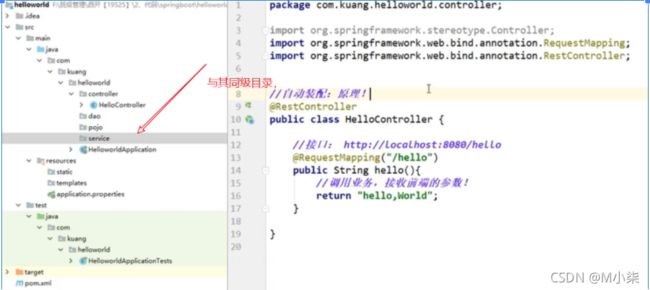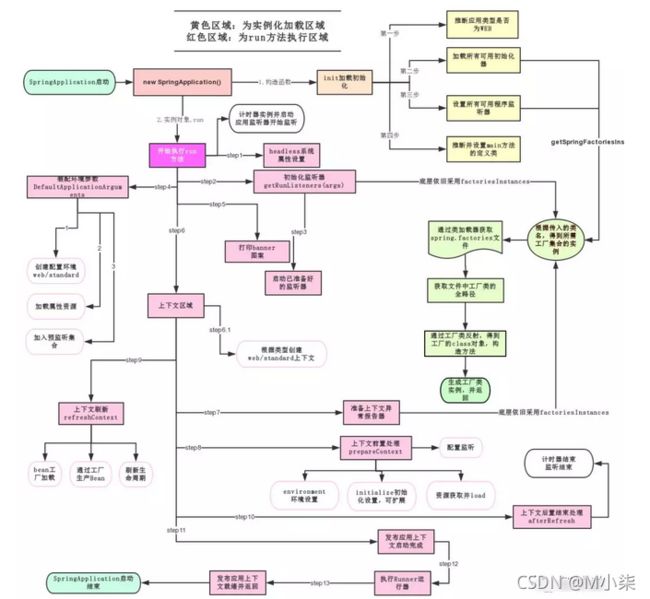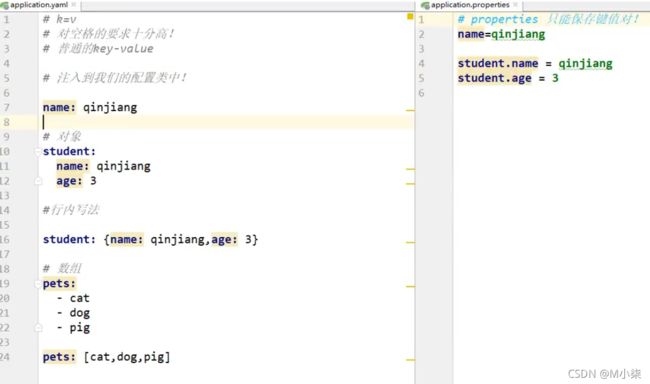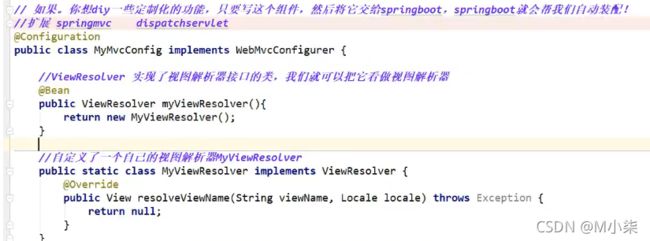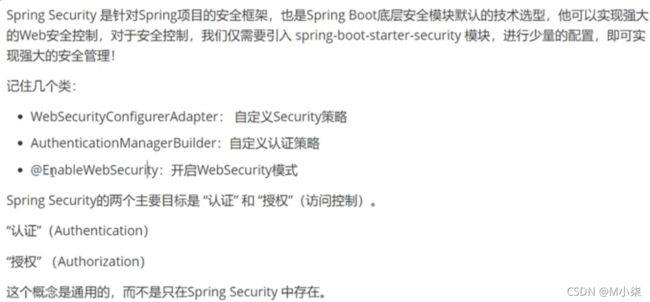SpringBoot笔记-狂神说
目录
p2:什么是springBoot
p3:什么是微服务架构
p4:第一个SpringBoot程序
p5:Idea创建及彩蛋
p6:Springboot自动装配原理
p7:主启动类
P8: yaml语法讲解
p9:给属性赋值的几种方式
p11:多环境切换
p12自动配置原理
SpringBoot web 开发
p15: 首页和图标定制
p16:Thymeleaf
p18:mvc配置原理
p19:springmvc拓展
p31:整合JDBC :
p32:整合Druid
p33:整合Mybatis
p34:SpringSecurity
p2:什么是springBoot
Spring Boot 基于 Spring 开发,Spirng Boot 本身并不提供 Spring 框架的核心特性以及扩展功能,只是用于快速、敏捷地开发新一代基于 Spring 框架的应用程序。也就是说,它并不是用来替代 Spring 的解决方案,而是和 Spring 框架紧密结合用于提升 Spring 开发者体验的工具。Spring Boot 以约定大于配置的核心思想,默认帮我们进行了很多设置,多数 Spring Boot 应用只需要很少的 Spring 配置。同时它集成了大量常用的第三方库配置(例如 Redis、MongoDB、Jpa、RabbitMQ、Quartz 等等),Spring Boot 应用中这些第三方库几乎可以零配置的开箱即用。
简单来说就是SpringBoot其实不是什么新的框架,它默认配置了很多框架的使用方式,就像maven整合了所有的jar包,spring boot整合了所有的框架 。
p3:什么是微服务架构
p4:第一个SpringBoot程序
创建一个新项目
2、选择spring initalizr , 可以看到默认就是去官网的快速构建工具那里实现
3、填写项目信息
4、选择初始化的组件(初学勾选 Web 即可)
5、填写项目路径
6、等待项目构建成功
7.启动测试。
p5:Idea创建及彩蛋
resources资源目录下,创建bannner.txt文件,可以修改启动时显示的字符
p6:Springboot自动装配原理
pom.xml中包含了大量的核心依赖
- Spring-boot-dependencies : 核心依赖在父工程中!
- 我们在或者引入一些Springboot依赖的时候, 不需要指定版本,就因为有这些版本仓库
<dependency>
<groupId>org.springframework.bootgroupId>
<artifactId>spring-boot-starter-webartifactId>
dependency>- 启动器:说白了就是Springboot的启动场景;
-
比如Spring-boot-starter-web, 他就会帮我们自动导入web环境所有的依赖!
-
Springboot会将所有的功能场景, 都变成一个个的启动
主程序
p7:主启动类
SpringApplication.run分析
1、推断应用的类型是普通的项目还是Web项目
2、查找并加载所有可用初始化器 , 设置到initializers属性中
3、找出所有的应用程序监听器,设置到listeners属性中
4、推断并设置main方法的定义类,找到运行的主类(run方法中的监听器,获取上下文,处理bean,)
P8: yaml语法讲解
-
application.yml
- 语法结构 :key:空格 value
server:
port: 8081
比较:
p9:给属性赋值的几种方式
yaml可以直接给实体类赋值
方法1
方法2:
在yaml写好配置,
person:
name: kuang
age: 3
happy: true
birth: 2020/7/27
maps: {k1: v1,k2: v2}
lists:
- code
- music
dog:
name: 旺旺
age: 3
在实体类上加上注解,注解的prefix值要和配置文件中的属性名相同
@ConfigurationProperties(prefix = "person")
p10:JSR303数据校验
使用
-
在实体类上增加
@Validated注解 -
在实体属性上增加以下注解即可实现相应的校验,在注解内加入
message属性可以指定校验未通过时的提示信息
空检查
@Null 验证对象是否为null
@NotNull 验证对象是否不为null, 无法查检长度为0的字符串
@NotBlank 检查约束字符串是不是Null还有被Trim的长度是否大于0,只对字符串,且会去掉前后空格.
@NotEmpty 检查约束元素是否为NULL或者是EMPTY.
Booelan检查
@AssertTrue 验证 Boolean 对象是否为 true
@AssertFalse 验证 Boolean 对象是否为 false
长度检查
@Size(min=, max=) 验证对象(Array,Collection,Map,String)长度是否在给定的范围之内
@Length(min=, max=) Validates that the annotated string is between min and max included.
日期检查
@Past 验证 Date 和 Calendar 对象是否在当前时间之前,验证成立的话被注释的元素一定是一个过去的日期
@Future 验证 Date 和 Calendar 对象是否在当前时间之后 ,验证成立的话被注释的元素一定是一个将来的日期
@Pattern 验证 String 对象是否符合正则表达式的规则,被注释的元素符合制定的正则表达式,regexp:正则表达式 flags: 指定 Pattern.Flag 的数组,表示正则表达式的相关选项。
数值检查
建议使用在Stirng,Integer类型,不建议使用在int类型上,因为表单值为“”时无法转换为int,但可以转换为Stirng为”“,Integer为null
@Min 验证 Number 和 String 对象是否大等于指定的值
@Max 验证 Number 和 String 对象是否小等于指定的值
@DecimalMax 被标注的值必须不大于约束中指定的最大值. 这个约束的参数是一个通过BigDecimal定义的最大值的字符串表示.小数存在精度
@DecimalMin 被标注的值必须不小于约束中指定的最小值. 这个约束的参数是一个通过BigDecimal定义的最小值的字符串表示.小数存在精度
@Digits 验证 Number 和 String 的构成是否合法
@Digits(integer=,fraction=) 验证字符串是否是符合指定格式的数字,interger指定整数精度,fraction指定小数精度。
@Range(min=, max=) 被指定的元素必须在合适的范围内
@Range(min=10000,max=50000,message=”range.bean.wage”)
@Valid 递归的对关联对象进行校验, 如果关联对象是个集合或者数组,那么对其中的元素进行递归校验,如果是一个map,则对其中的值部分进行校验.(是否进行递归验证)
@CreditCardNumber信用卡验证
@Email 验证是否是邮件地址,如果为null,不进行验证,算通过验证。
@ScriptAssert(lang= ,script=, alias=)
@URL(protocol=,host=, port=,regexp=, flags=)
p11:多环境切换
yaml多环境切换
用---来分隔多个文件,使用profiles的active来选择调用哪个环境
server:
port: 8081
spring:
profiles:
active: dev
---
server:
port: 8082
spring:
profiles: dev
---
server:
port: 8083
spring:
profiles: test
p12自动配置原理
SpringBoot web 开发
静态资源总结:
在springboot,我们 可以使用以下方式处理静态资源
webjarslocalhost:8080/wbjars/
Public, static,/**,resources, localhost:8080
优先级:resources>static>(默认)>public
p15: 首页和图标定制
p16:Thymeleaf
模板引擎的作用就是我们来写一个页面模板,比如有些值呢,是动态的,我们写一些表达式。而这些值,从哪来呢,就是我们在后台封装一些数据。然后把这个模板和这个数据交给我们模板引擎,模板引擎按照我们这个数据帮你把这表达式解析、填充到我们指定的位置,然后把这个数据最终生成一个我们想要的内容给我们写出去,这就是我们这个模板引擎,
Thymeleaf 官网:https://www.thymeleaf.org/
Thymeleaf 在Github 的主页:https://github.com/thymeleaf/thymeleaf
Spring官方文档:找到我们对应的版本
https://docs.spring.io/spring-boot/docs/2.2.5.RELEASE/reference/htmlsingle/#using-boot-starter
<dependency>
<groupId>org.springframework.bootgroupId>
<artifactId>spring-boot-starter-thymeleafartifactId>
dependency>Thymeleaf的使用语法
遍历:

p18:mvc配置原理
p19:springmvc拓展

p31:整合JDBC :
新建一个项目,选择引入JDBC API、mysql Driver和Spring Web;
编写yaml配置文件:
spring:
datasource:
username: root
password: 123456
#?serverTimezone=UTC解决时区的报错
url: jdbc:mysql://localhost:3306/springboot?serverTimezone=UTC&useUnicode=true&characterEncoding=utf-8
driver-class-name: com.mysql.cj.jdbc.Driver配置后,我们就可以直接去使用了,因为SpringBoot已经默认帮我们进行了自动配置;去测试类测试
@SpringBootTest
class SpringbootDataJdbcApplicationTests {
//DI注入数据源
@Autowired
DataSource dataSource;
@Test
public void contextLoads() throws SQLException {
//看一下默认数据源
System.out.println(dataSource.getClass());
//获得连接
Connection connection = dataSource.getConnection();
System.out.println(connection);
//关闭连接
connection.close();
}
}打印输出我们配置的数据源为 : class com.zaxxer.hikari.HikariDataSource;这里导入的类都在 DataSourceConfiguration 配置类下,可以看出 Spring Boot 2.2.5 默认使用HikariDataSource 数据源,而以前版本,如 Spring Boot 1.5 默认使用 org.apache.tomcat.jdbc.pool.DataSource 作为数据源;
HikariDataSource 号称 Java WEB 当前速度最快的数据源,相比于传统的 C3P0 、DBCP、Tomcat jdbc 等连接池更加优秀;可以使用 spring.datasource.type 指定自定义的数据源类型,值为 要使用的连接池实现的完全限定名。
p34:SpringSecurity
JDBCTemplate对象
1、有了数据源(com.zaxxer.hikari.HikariDataSource),然后可以拿到数据库连接(java.sql.Connection),有了连接,就可以使用原生的 JDBC 语句来操作数据库;
2、即使不使用第三方第数据库操作框架,如 MyBatis等,Spring 本身也对原生的JDBC 做了轻量级的封装,即JdbcTemplate。
3、数据库操作的所有 CRUD 方法都在 JdbcTemplate 中。
4、Spring Boot 不仅提供了默认的数据源,同时默认已经配置好了 JdbcTemplate 放在了容器中,程序员只需自己注入即可使用
5、JdbcTemplate 的自动配置是依赖 org.springframework.boot.autoconfigure.jdbc 包下的 JdbcTemplateConfiguration 类
JdbcTemplate主要提供以下几类方法:
-
execute方法:可以用于执行任何SQL语句,一般用于执行DDL语句;
-
update方法及batchUpdate方法:update方法用于执行新增、修改、删除等语句;batchUpdate方法用于执行批处理相关语句;
-
query方法及queryForXXX方法:用于执行查询相关语句;
-
call方法:用于执行存储过程、函数相关语句。
编写controller,注入jdbcTemplate,测试一下
package com.chang.controller;
import org.springframework.beans.factory.annotation.Autowired;
import org.springframework.jdbc.core.JdbcTemplate;
import org.springframework.web.bind.annotation.GetMapping;
import org.springframework.web.bind.annotation.PathVariable;
import org.springframework.web.bind.annotation.RestController;
import java.util.List;
import java.util.Map;
@RestController
public class JDBCController {
@Autowired
JdbcTemplate jdbcTemplate;
//查询数据库所有信息
//Map中的key对应数据库中的字段名,value对应数据库的字段值
@GetMapping("/userList")
public List> userList() {
String sql = "select * from user";
List> list_maps = jdbcTemplate.queryForList(sql);
return list_maps;
}
//新增一个用户
@GetMapping("/addUser")
public String addUser() {
String sql = "insert into mybatis.user(id,name,pwd) values(6,'李华','43456')";
jdbcTemplate.update(sql);
return "update-ok";
}
//修改一个用户
@GetMapping("/updateUser/{id}")
public String updateUser(@PathVariable("id") int id) {
//插入语句
String sql = "update mybatis.user set name=?,pwd=? where id=" + id;
//数据
Object[] objects = new Object[2];
objects[0] = "小小";
objects[1] = "ooooooo";
jdbcTemplate.update(sql, objects );
return "updateUser-ok";
}
//删除用户
@GetMapping("/deleteUser/{id}")
public String deleteUser(@PathVariable("id") int id) {
String sql = "delete from mybatis.user where id=?" + id;
jdbcTemplate.update(sql);
return "deleteUser-ok";
}
}
p32:整合Druid
Druid 是阿里巴巴开源平台上一个数据库连接池实现,结合了 C3P0、DBCP 等 DB 池的优点,同时加入了日志监控。Druid 可以很好的监控 DB 池连接和 SQL 的执行情况,天生就是针对监控而生的 DB 连接池。
配置数据源
<dependency>
<groupId>com.alibabagroupId>
<artifactId>druidartifactId>
<version>1.1.21version>
dependency>切换数据源,之前已经说过 Spring Boot 2.0 以上默认使用 com.zaxxer.hikari.HikariDataSource 数据源,但可以 通过 spring.datasource.type 指定数据源。切换成功后,就可以设置数据源连接初始化大小、最大连接数、等待时间、最小连接数 等设置项;
spring:
datasource:
username: root
password: 123456
url: jdbc:mysql://localhost:3306/mybatis?serverTimezone=UTC&useUnicode=true&characterEncoding=utf-8
driver-class-name: com.mysql.cj.jdbc.Driver
type: com.alibaba.druid.pool.DruidDataSource # 自定义数据源
#Spring Boot 默认是不注入这些属性值的,需要自己绑定
#druid 数据源专有配置
initialSize: 5
minIdle: 5
maxActive: 20
maxWait: 60000
timeBetweenEvictionRunsMillis: 60000
minEvictableIdleTimeMillis: 300000
validationQuery: SELECT 1 FROM DUAL
testWhileIdle: true
testOnBorrow: false
testOnReturn: false
poolPreparedStatements: true
#配置监控统计拦截的filters,stat:监控统计、log4j:日志记录、wall:防御sql注入
#如果允许时报错 java.lang.ClassNotFoundException: org.apache.log4j.Priority
#则导入 log4j 依赖即可,Maven 地址:https://mvnrepository.com/artifact/log4j/log4j
filters: stat,wall,log4j
maxPoolPreparedStatementPerConnectionSize: 20
useGlobalDataSourceStat: true
connectionProperties: druid.stat.mergeSql=true;druid.stat.slowSqlMillis=500
导入Log4j 的依赖
<dependency>
<groupId>log4jgroupId>
<artifactId>log4jartifactId>
<version>1.2.17version>
dependency>为 DruidDataSource 绑定全局配置文件中的参数,再添加到容器中,而不再使用 Spring Boot 的自动生成了;我们需要 自己添加 DruidDataSource 组件到容器中,并绑定属性;创建DruidConfig文件:
package com.chang.config;
import com.alibaba.druid.pool.DruidDataSource;
import com.alibaba.druid.support.http.StatViewServlet;
import com.alibaba.druid.support.http.WebStatFilter;
import org.springframework.boot.context.properties.ConfigurationProperties;
import org.springframework.boot.web.servlet.FilterRegistrationBean;
import org.springframework.boot.web.servlet.ServletRegistrationBean;
import org.springframework.context.annotation.Bean;
import org.springframework.context.annotation.Configuration;
import javax.sql.DataSource;
import java.util.HashMap;
import java.util.Map;
@Configuration
public class DruidConfig {
@Bean
@ConfigurationProperties(prefix = "spring.datasource")
public DataSource druidDataSource() {
return new DruidDataSource();
}
@Bean
//后台监控功能
//因为SpringBoot内置了Servlet容器,所以没有Web.xml,替代方法:ServletRegistrationBean
public ServletRegistrationBean statViewServlet() {
ServletRegistrationBean bean = new ServletRegistrationBean<>(new StatViewServlet(), "/druid/*");
//后台需要有人登陆,账号密码配置
HashMap map = new HashMap<>();
//增加配置
map.put("loginUsername", "admin");//登陆的key,是固定的,不能自己定义成其他的
map.put("loginPassword", "123456");
//允许谁可以访问
map.put("allow", "localhost");
bean.setInitParameters(map);//初始化参数
return bean;
}
@Bean
//filter
public FilterRegistrationBean WebStartFilter() {
FilterRegistrationBean bean = new FilterRegistrationBean<>();
//设置过滤器
bean.setFilter(new WebStatFilter());
//可以过滤哪些请求
Map filters = new HashMap<>();
//这些东西不进行统计
filters.put("exclusions", "*.js,*.css,/druid/*");
bean.setInitParameters(filters);
return bean;
}
}
p33:整合Mybatis
导包,配置依赖
<dependency>
<groupId>org.mybatis.spring.bootgroupId>
<artifactId>mybatis-spring-boot-starterartifactId>
<version>2.1.1version>
dependency>配置文件
创建pojo 包,创建user类
package com.chang.pojo;
import lombok.AllArgsConstructor;
import lombok.Data;
import lombok.NoArgsConstructor;
@Data
@AllArgsConstructor
@NoArgsConstructor
public class User {
}
创建Mapper,userMapper
package com.chang.mapper;
import com.chang.pojo.User;
import org.apache.ibatis.annotations.Mapper;
import org.springframework.stereotype.Repository;
import java.util.List;
@Mapper
@Repository
public interface UserMapper {
List queryUserList() ;
User queryUserById(int id);
int addUser(User user);
int updateUser(User user);
int deleteUser(int id);
}
resources资源下,创建mybatis--->mapper包,创建 UserMapper.xml文件
xml version="1.0" encoding="UTF-8" ?>
<mapper namespace="com.chang.mapper.UserMapper">
<select id="queryUserList" resultType="com.chang.pojo.User">
select * from user
select>
<select id="queryUserById" resultType="User">
select * from user where id = #{id}
select>
<insert id="addUser" parameterType="User">
insert into user (id,name,pwd) values (#{id},#{name},#{pwd})
insert>
<update id="updateUser" parameterType="User">
update user set name=#{name},pwd=#{pwd} where id = #{id}
update>
<delete id="deleteUser" parameterType="int">
delete from user where id = #{id}
delete>
mapper>编写部门的 Controller
package com.chang.controller;
import com.chang.mapper.UserMapper;
import com.chang.pojo.User;
import org.springframework.beans.factory.annotation.Autowired;
import org.springframework.web.bind.annotation.GetMapping;
import org.springframework.web.bind.annotation.RestController;
import java.util.List;
@RestController
public class UserController {
@Autowired
private UserMapper userMapper;
@GetMapping("/999")
public List queryUserList() {
List userList = userMapper.queryUserList();
for (User user : userList) {
System.out.println(user);
}
return userList;
}
// 添加一个用户
@GetMapping("addUser")
public String addUser(){
userMapper.addUser(new User(99,"yzs","444"));
return "OK";
}
// 修改一个用户
@GetMapping("/updateUser")
public String updateUser(){
userMapper.updateUser(new User(5,"5","5"));
return "ok";
}
// 根据id删除用户
@GetMapping("deleteUser")
public String deleteUser(){
userMapper.deleteUser(5);
return "ok";
}
}
p34:SpringSecurity
“认证”(Authentication)
身份验证是关于验证您的凭据,如用户名/用户ID和密码,以验证您的身份。
身份验证通常通过用户名和密码完成,有时与身份验证因素结合使用。
“授权” (Authorization)
授权发生在系统成功验证您的身份后,最终会授予您访问资源(如信息,文件,数据库,资金,位置,几乎任何内容)的完全权限。
这个概念是通用的,而不是只在Spring Security 中存在。
引入 Spring Security 模块
<dependency>
<groupId>org.springframework.bootgroupId>
<artifactId>spring-boot-starter-securityartifactId>
dependency>编写 Spring Security 配置类
定义认证规则,重写configure(AuthenticationManagerBuilder auth)方法,这里设置密码加密auth.inMemoryAuthentication().passwordEncoder(new BCryptPasswordEncoder())否则会报There is no PasswordEncoder mapped for the id "null"错误.
package com.chang.config;
import org.springframework.security.config.annotation.authentication.builders.AuthenticationManagerBuilder;
import org.springframework.security.config.annotation.web.builders.HttpSecurity;
import org.springframework.security.config.annotation.web.configuration.EnableWebSecurity;
import org.springframework.security.config.annotation.web.configuration.WebSecurityConfigurerAdapter;
import org.springframework.security.crypto.bcrypt.BCryptPasswordEncoder;
@EnableWebSecurity // 开启WebSecurity模式
public class SecurityConfig extends WebSecurityConfigurerAdapter {
@Override
protected void configure(HttpSecurity http) throws Exception {
// 定制请求的授权规则
// 首页所有人可以访问
http.authorizeRequests().antMatchers("/").permitAll()
.antMatchers("/level1/**").hasRole("vip1")
.antMatchers("/level2/**").hasRole("vip2")
.antMatchers("/level3/**").hasRole("vip3");
//没有默认权限,会登录页面
http.formLogin();
}
//定义认证规则,重写configure(AuthenticationManagerBuilder auth)方法
@Override
protected void configure(AuthenticationManagerBuilder auth) throws Exception {
auth.inMemoryAuthentication().passwordEncoder(new BCryptPasswordEncoder())
.withUser("haha").password(new BCryptPasswordEncoder().encode("123456")).roles("vip2","vip3")
.and()
.withUser("root").password(new BCryptPasswordEncoder().encode("123456")).roles("vip1","vip2","vip3")
.and()
.withUser("guest").password(new BCryptPasswordEncoder().encode("123456")).roles("vip1");
}
}
编写routerController测试
package com.chang.controller;
import org.springframework.stereotype.Controller;
import org.springframework.web.bind.annotation.PathVariable;
import org.springframework.web.bind.annotation.RequestMapping;
@Controller
public class RouterController {
@RequestMapping({
"/","/index"})
public String index(){
return "index";
}
@RequestMapping("/toLogin")
public String toLogin(){
return "views/login.html";
}
@RequestMapping("level1/{id}")
public String level1(@PathVariable("id") int id){
return "views/level1/"+id;
}
@RequestMapping("level2/{id}")
public String level2(@PathVariable("id") int id){
return "views/level2/"+id;
}
@RequestMapping("level3/{id}")
public String level3(@PathVariable("id") int id){
return "views/level3/"+id;
}
}
测试,并且每个角色只能访问自己认证下的规则。
注销及权限控制
例:用户没有登录的时候,导航栏上只显示登录按钮,用户登录之后,导航栏可以显示登录的用户信息及注销按钮!还有就是,比如admin这个用户,它只有 vip2,vip3功能,那么登录则只显示这两个功能,而vip1的功能菜单不显示!
导入它们相关联的包
<dependency>
<groupId>org.thymeleaf.extrasgroupId>
<artifactId>thymeleaf-extras-springsecurity5artifactId>
<version>3.0.4.RELEASEversion>
dependency>在前端,增加一个注销的按钮,index.html 导航栏中,index代码如下,注意导入xmlns:sec="http://www.thymeleaf.org/thymeleaf-extras-springsecurity5"
<html lang="en" xmlns:th="http://www.thymeleaf.org"
xmlns:sec="http://www.thymeleaf.org/extras/spring-security">
<head>
<meta charset="UTF-8">
<meta name="viewport" content="width=device-width, initial-scale=1, maximum-scale=1">
<title>首页title>
<link href="https://cdn.bootcss.com/semantic-ui/2.4.1/semantic.min.css" rel="stylesheet">
<link th:href="@{/qinjiang/css/qinstyle.css}" rel="stylesheet">
head>
<body>
<div class="ui container">
<div class="ui segment" id="index-header-nav" th:fragment="nav-menu">
<div class="ui secondary menu">
<a class="item" th:href="@{/index}">首页a>
<div sec:authorize="!isAuthenticated()">
<a class="item" th:href="@{/login}">
<i class="address card icon">i> 登录
a>
div>
<div sec:authorize="isAuthenticated()">
<a class="item">
<i class="address card icon">i>
用户名:<span sec:authentication="principal.username">span>
角色:<span sec:authentication="principal.authorities">span>
a>
div>
<div sec:authorize="isAuthenticated()">
<a class="item" th:href="@{/logout}">
<i class="sign-out icon">i> 注销
a>
div>
div>
div>
<div class="ui segment" style="text-align: center">
<h3>Spring Security Study by 常常h3>
div>
<div>
<br>
<div class="ui three column stackable grid">
<div class="column" sec:authorize="hasRole('vip1')">
<div class="ui raised segment">
<div class="ui">
<div class="content">
<h5 class="content">Level 1h5>
<hr>
<div><a th:href="@{/level1/1}"><i class="bullhorn icon">i> Level-1-1a>div>
<div><a th:href="@{/level1/2}"><i class="bullhorn icon">i> Level-1-2a>div>
<div><a th:href="@{/level1/3}"><i class="bullhorn icon">i> Level-1-3a>div>
div>
div>
div>
div>
<div class="column" sec:authorize="hasRole('vip2')">
<div class="ui raised segment">
<div class="ui">
<div class="content">
<h5 class="content">Level 2h5>
<hr>
<div><a th:href="@{/level2/1}"><i class="bullhorn icon">i> Level-2-1a>div>
<div><a th:href="@{/level2/2}"><i class="bullhorn icon">i> Level-2-2a>div>
<div><a th:href="@{/level2/3}"><i class="bullhorn icon">i> Level-2-3a>div>
div>
div>
div>
div>
<div class="column"sec:authorize="hasRole('vip3')">
<div class="ui raised segment">
<div class="ui">
<div class="content">
<h5 class="content">Level 3h5>
<hr>
<div><a th:href="@{/level3/1}"><i class="bullhorn icon">i> Level-3-1a>div>
<div><a th:href="@{/level3/2}"><i class="bullhorn icon">i> Level-3-2a>div>
<div><a th:href="@{/level3/3}"><i class="bullhorn icon">i> Level-3-3a>div>
div>
div>
div>
div>
div>
div>
div>
<script th:src="@{/qinjiang/js/jquery-3.1.1.min.js}">script>
<script th:src="@{/qinjiang/js/semantic.min.js}">script>
body>
html>如果注销404了,就是因为它默认防止csrf跨站请求伪造,因为会产生安全问题,我们可以将请求改为post表单提交,或者在spring security中关闭csrf功能;我们试试:在 配置中增加 http.csrf().disable();
测试根据登陆的用户分别显示不同的界面。
记住我首页定制
//定制请求的授权规则
@Override
protected void configure(HttpSecurity http) throws Exception {
//。。。。。。。。。。。
//记住我,保存2周
http.rememberMe();
}
定制登录页
http.formLogin().loginPage("/toLogin");前端也需要指向我们自己定义的 login请求
<a class="item" th:href="@{/toLogin}">
<i class="address card icon">i> 登录
a>login页面
<html lang="en" xmlns:th="http://www.thymeleaf.org">
<head>
<meta charset="UTF-8">
<meta name="viewport" content="width=device-width, initial-scale=1, maximum-scale=1">
<title>登录title>
<link href="https://cdn.bootcss.com/semantic-ui/2.4.1/semantic.min.css" rel="stylesheet">
head>
<body>
<div class="ui container">
<div class="ui segment">
<div style="text-align: center">
<h1 class="header">登录h1>
div>
<div class="ui placeholder segment">
<div class="ui column very relaxed stackable grid">
<div class="column">
<div class="ui form">
<form th:action="@{/toLogin}" method="post">
<div class="field">
<label>Usernamelabel>
<div class="ui left icon input">
<input type="text" placeholder="Username" name="username">
<i class="user icon">i>
div>
div>
<div class="field">
<label>Passwordlabel>
<div class="ui left icon input">
<input type="password" name="password">
<i class="lock icon">i>
div>
div>
<div class="field">
<input type="checkbox" name="remember"> 记住我
div>
<input type="submit" class="ui blue submit button"/>
form>
div>
div>
div>
div>
<div style="text-align: center">
<div class="ui label">
i>注册
div>
<br><br>
<small>blog.kuangstudy.comsmall>
div>
<div class="ui segment" style="text-align: center">
<h3>Spring Security Study by 常常h3>
div>
div>
div>
<script th:src="@{/qinjiang/js/jquery-3.1.1.min.js}">script>
<script th:src="@{/qinjiang/js/semantic.min.js}">script>
body>
html>
